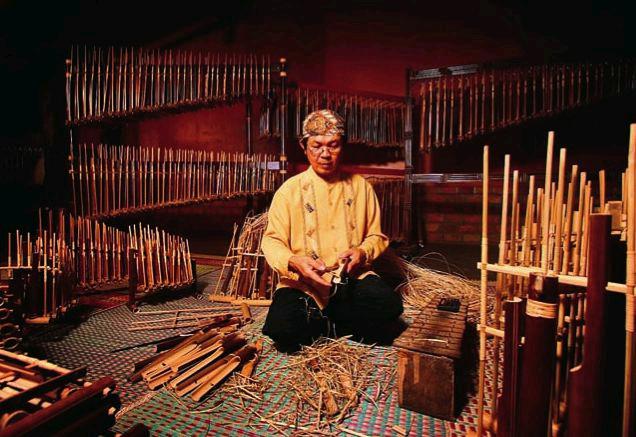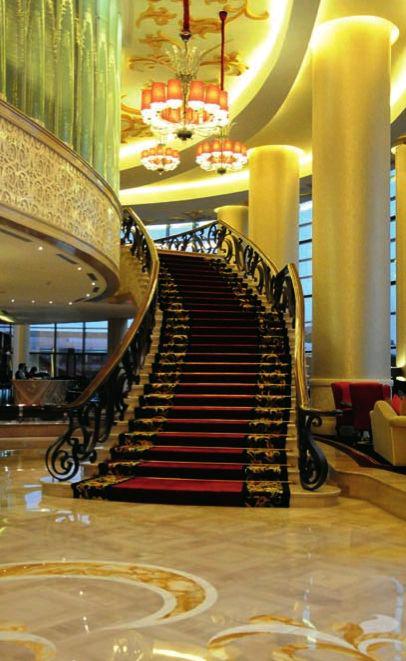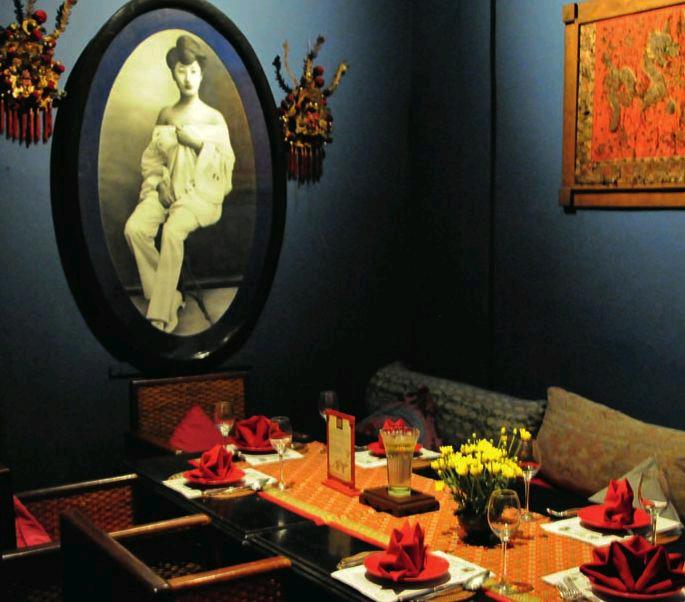西爪哇的狂欢序曲
国慧
爪哇岛作为印尼第一大主岛当之无愧为最具人文气息的地域。在西爪哇岛,从首府万隆开始,与温泉同乐,耳听竹节碰撞般清脆的昂格隆音乐,再到首都雅加达一睹老城的丰厚和慈悲,旅行的欢愉似乎就藏匿于浓墨重彩的景色中,古老的广场上以及当地人深邃的眼眸里。发现印尼,应该从西爪哇岛开始。
Java dominates Indonesia politically, economically and culturally. On West Java,"Angklung" bamboo orchestra as well as the classical Sundanese gamelan and dances echoes the passage from provincial capital of Bandung to nations capital Jakarta. Humanity and vicissitudes of Old Jakarta, along with delight of travel are hidden in the splendid scenes, ancient squares and discerning looks of the local residents. Discover Indonesia should begin in West Java.
BANDUNG,THE FAIRY KINGDOM
Bandung meaning "the fairy kingdom" derives from its hilly volcanic terrain. To Indonesians, the city gained fame in 1955 as the venue for the first AfroAsian Conference. Nowadays, the streets of Bandung still pulse with the charm of multiethnic cultures, as unspoiled natural landscape and concrete jungle of modern urban scene form the conflicted beauty. The city like smoldering volcanoes is both unique and mystifying.
FOR A SENSIBLE TRIP
The trip began at wee hours of the morning. At 6:30 am, as sun was just breaking the darkness in Beijing, we headed to Soekarno–Hatta International Airport (CGK), seven and half hour flight crossing one time zone. We gained one hour daylight when landing in Jakarta. Indonesia doesnt have alternations of four seasons, with only wet and dry seasons. Summer is the carefree time, and for new arrivals still in harsh winter a few hours earlier, the exotic aura started to sink in.
The first stop was Bandung. Tol Cikampek expressway connecting Bandung and Jakarta was built in commemoration of 50th anniversary of Bandung Conference. Heading west, flat and wide thoroughfares and modern buildings gradually gave way to verdant vegetation, as we left city center behind. Tropical region began exhibiting its abundance, with palm trees, coconut trees and frangipani trees occupying your vision. Many plants faded away before you could call their names, but another wonder was just around the corner.
SOAKING IN SARI ATER HOT SPRING RESORT
Sari Ater Hot Spring Resort lies in the middle of spreading clove and tea plantation, Subang, some distance from Bandung. Its getting late when I arrived at Sari Ater; its not as brightly lit as urban center, but indulging in another kind of excitement. Walking uphill along the slab stone path from the entrance, tourists laughing intermingled with waterfall thunders. The hot spring that comes from Tangkuban perahus cauldron forms natural hot spring pool at the lower and flatter terrain. We dropped off shoes jumping into the open-air hot spring pools, to seek fun of being soaked from head to toe.

The Kedai Sunan Ambu restaurant located in the resort offers authentic Indonesian recipes like the yummy pineapple fried rice and grilled chicken breast. Nothing beats biting into the sweet, juicy, and slightly tangy pineapple that bursts with freshness and flavors, especially when spraying on it a drop of zingy Indonesian pepper sauce. After dining, we rode on eco-vehicle to the resort lodging. Sari Ater Resort offers getaways in peaceful landscapes, gurgling spring and chirping insects and birds making up the symphony. To have a view on the accommodation exterior by roadside lights: singular house with thatch roof and bamboo rattan covered fa?ade; each guest house opened to a lush green yard, the sight in idyllic poem.
DISCERNING DREAM FROM
ANGKLUNG MUSIC
Angklung is the most representative music instrument of West Java. It made of two bamboo tubes attached to a bamboo frame. The tubes are carved to have a resonant pitch when struck and are tuned to octaves. The base of the frame is held in one hand, whilst the other hand strikes the instrument. This causes a repeating note to sound. The sound"klung" comes from the instrument, and each of three or more performers in an angklung ensemble play just one note or more, but altogether complete melodies are produced. It was said that Dutch occupiers only allowed local beggars to perform angklung, fearful of playing the instrument would galvanize locals to resist against foreign invasion and colonialism.
At Bandungs angklung performing school, student ensemble staged live performance, as the performer number in an ensemble adjusted to different piece of music. The finale was the classic song “Heal the World” by Michael Jackson that required full participation. The Angklung music with strong emotions evoked a combination of sacred sweetness and sadness, moving everyone at presence.
UNLOCK SECRECY OF COFFEE FROM TIP OF TONGUE
Indonesias Java, Sumatra and Sulawesi are the main coffee producing areas. In middle 17th century, then Dutch governor shipped coffee seedlings to Ceylon and Java. Into 18th century, Javanese coffee gained global popularity. Thus, the name "Java" today has become a synonym for coffee. Specialty almost all specialty Arabica coffee was for export to Europe. However, by the end of 19th century, the coffee rust disease swept through Indonesia, wiping out most of cultivation. Robusta coffee was introduced to East Java from Africa as a substitute especially at lower altitudes. Today, 90% of Indonesian coffee beans are Robusta, Arabica only 10%.
Indonesia has another type of coffee, the most expensive one in the world, Kopi Luwak or civet coffee. Kopi is the Indonesian word for coffee. Luwak is a local name of the Asian Palm Civet in Sumatra. Palm civets are primarily frugivorous, feeding on berries and pulpy fruits; then in the digestive tract, fermentation occurs. The natives collected these luwaks coffee seed droppings, then cleaned, roasted and ground them to make their own coffee beverage. It is less acid, and because of its rarity and unusual process, the civet coffee fetches high price at a few hundred dollars per pound. The traditional method of collecting feces from wild civets has given way to intensive farming methods in which solitary civets in battery cage systems are force fed the coffee beans. This method of production has raised ethical concerns.
BRAGA STREET IN OBSERVATION OF TIME
Braga Street (official name in Indonesian: Jalan Braga) retains architectural style of Dutch Indies, as taverns, coffeehouses, hotels and galleries make up most of the storefronts. In the morning, balmy sunshine Braga Street projected a golden shine to assorted store signs and plaques. On the sidewalks, food peddlers were pitching local snacks on the cart, while sloppy locals chatted with store clerks, without business urgency.
Braga Parmai is the one of legendary restaurants on Braga Street that opened during Dutch Indies period. Tulip pattern on the glass sliding door, wood-paneled floor leads to the second floor, where Dutch people used to lodge. Further ahead, stands Sumber Hidangan, old antique bread shop & restaurant serving original Dutch style breads & cookies. The number“1929”, birth year sign on the glass window, is enough to slow down passersby; everything here is vintage, unadorned old-fashion glass cabinet with aluminum-plated border, somewhat murky from oxidation. Square four-seat tables scattered in the room, as the high ceiling accentuates its loneliness and idleness.
IN VIEW OF BILLOWING VOLCANO SPECTACLE
Indonesia is a country active in volcanic activities, as over 400 volcanoes scatter around the country. Java has its fair share of over 100 volcanoes, and 30 of them remain active. Tangkuban perahu is an active volcano, situated 30 km north of the city of Bandung, and its the only crater in Indonesia that you can drive up to its very rim. Car making its way through bending mountain road climbed to altitude of 2,200 meters cutting through dense clouds. Mount Tangkuban Perahu has a distinctive shape, and looks like an “overturned boat” in brown color. The huge crater is an astonishing view. Here you were greeted by sulfur fumes which the crater continues to emit although the volcano is not active, as muddy-like lava filled up crater pit as if in the process of eruption.
CIWIDEY, STORY OF TEA PLANTATION AND CRATER LAKE
In the constantly changing sceneries of Bandung, Ciwidey is a thick splash. A small town over 30km from Bandung, Ciwidey is famed for fertile land, green tea plantation and Kawah Puti, or White Crater by the locals. Tourists often rent their own cars at Bandung, and it takes two and half hours from downtown Bandung.
ASIAN AFRICAN CONFERENCE MUSEUM
The historic first Asian African Conference with profound legacy has the root in the mistaken concept held by people that Bandung is a place steeped in politics. However, the Bandung Conference placed the hosting city under global spotlight, hence the birth of Bandung Spirit. The Asian-African Museum is located at Jalan Asia Afrika in Bandung, a creamy white three-story building. The idea of establishing a Museum of the AsianAfrican Conference at Gedung Merdeka was delivered in the meeting of the Committee for the Commemoration of the 25th Anniversary of the Asian-African Conference in 1980.
LOST IN THE MAGIC STREET BLOCK
Bandung not only boasts natural beauty but well-designed indoor theme park, the world full of magic. Integrated Trans Studio Bandung Complex, the biggest shopping complex in Bandung, incorporates theme parks, shopping mall and upscale hotel, offering 20 exciting rides and entertainment with the famous Broadway style. From far distance, you were struck by the fastest roller coaster in the world at Trans Studio with sensational backward movement maneuver. Trans Studio Bandung Theme Park is divided into three parts: Studio Central, the Famous Hollywood is right in front of you and you can find theme shops selling souvenirs of favorite stars; Lost City, you will experience an amazing trip and prepare for the thrilling adventure; Magic Corner, reveals the veil of mystery and fulfill your curiosity in the world of magic, as you will observe the formation of thunder and lightning, transmission of sound wave and application of gravity. An exciting island you wont forget.
JAKARTA, BIG DURIAN, A CITY WE LEARN TO LOVE
As a capital city with rich history, Jakarta faces dilemma in the blending of tradition and modernity. The imprints of history have gradually fading in line with the development of the times, as the relentless process results in imbalance and unevenness. Therefore, when you are in the midst of Jakartas traffic congestion, it becomes very difficult for you to love this place. However, you will start understanding, forgiving and attaching hope for its future, when you realize that over 17 million inhabitants who have converged here are coping with same problems.
IN TOUCH WITH THE SOUL OF JAKARTA
Old town is the soul of a city. For Jakarta with a modern administrative center on golden triangle, its old town Kota also known as Old Jakarta, once a center of commerce for the whole continent due to its strategic location and abundant resources, has gained more nostalgia. Fatahillah Square is a 1.8 acre paved open space that used to be the social and political center of the Dutch empire in the East Indies. The Stadthuis to its south used to be the headquarters of the Dutch East India Company and the Dutch colonial government. Across the square from the Batavia Caféstands the Jakarta History Museum, housing documents dating back to pre-colonial times, and weapons from European and Indonesian powers alike. Once the Museum closed at dusk, local street artists would take over the space, staging customs performance. For instance, a barrel clown in folk costume, who in semicrouching position held a wooden barrel on his back; his companion, a symbol of justice, swung violently lash flogging the barrel and ground as punishment. It lacked aesthetic beauty, but it lauded justice in an original fashion.
MELTING POT OF FOOD
Jakarta has a vast range of food available at hundreds of eating complexes located all over the city, from modest street-side foodstalls and traveling vendors to the high-class expensive restaurants. However, authentic Indonesian dishes are still most appealing. Some popular dishes that originated in Indonesia are now common across much of Southeast Asia. Like the splendid natural landscapes of Indonesia, spices mixture or seasoning become the integral part of Indonesian cuisine.
BEAUTIFUL INDONESIA MINIATURE PARK
Located in southern suburb of Jakarta, Taman Mini with its diverse style architecture cluster steals the attention of anyone passing by. It perhaps will arouse your sigh of wonder when standing in front of Taman Mini Indonesia Indah, “its serious indeed.”
A BATIK CLASS
It would be impossible to visit or live in Indonesia and not be exposed to one of the countrys most highly developed art forms, batik. Different regions of Indonesia have their own unique batik patterns that normally take themes from everyday lives, incorporating patterns such as flowers, nature, animals, folklore or people. However, on our trip, we only saw batik clothing at street-side shops; only until we took a batik class at a batik textiles museum did we gain insight into design and production of batik.
BANDUNG, THE FAIRY KINGDOM万隆 初遇灵性“仙之国”
印尼人称万隆为“仙之国”,得名于万隆山连山的美景。对国人来说,一场举世闻名的会议让万隆成为一个既熟悉又陌生的名字。如今,万隆大大小小的街巷中依然散发着多元文化的魅力,纯净的自然风景与夹杂着钢筋水泥的城市风貌形成一种矛盾的美感,这座城正如它火山口缭绕的烟雾一样,充满个性又让人琢磨不完。
FOR A SENSIBLE TRIP
酝酿一场感官之行
这次旅行从起个大早开始。从早上六点半天空微亮的北京到雅加达苏加诺-哈达国际场,七个半小时的航程让我们跨过一个时区,赢得一小时的白昼。印尼没有春夏秋冬的轮转,一年被简单又准确的分割为旱季和雨季,夏天是可以终肆无忌惮,对早上还处于初冬寒意里的人们来说,这是“异国风情”的最初的体现。
第一站是万隆。Tol Cikampek快速公路是从雅加达到万隆最快捷的公路,为纪念亚非会议50周年而修建。一路向西,起初还是宽阔平坦的市区大道与现代化建筑,随着向郊区靠近,窗外的主色调开始由城市的灰白转向沁人心脾的浓绿,热带地区逐渐显露它热浪下的丰饶,一片片高大的棕榈树、椰子树和鸡蛋花树无时不在填充你的视野,还有些植物在你疑惑它叫什么名字时已经被车子甩在身后,回过头来又是另一种浓艳。
曲折蜿蜒的乡间路上汽车很少,两旁的房屋则是五颜六色,明艳可爱,几乎每家门口都停靠着摩托车,常会看见当地男人把它们开得飞快。进入万隆生活模式前,需要调动所有感官。
SOAKING IN SARI ATER HOT SPRING RESORT
浸润在Sari Ater温泉度假村
Sari Ater温泉度假村在Subang的茶园之间,距离万隆还有一段距离,抵达Sari Ater时天已渐晚,没有城市里的华灯初上,却是另一派欢腾热闹。从景区大门沿着石板路往上走,温泉瀑布和人们欢笑的声音就不绝于耳了,这些温泉水从山上流下,积在地势低缓的地面成为天然的温泉池。在露天的开放式温泉池内,客人脱掉鞋子放在鞋柜里就可以奔泉水而去了,这是最简单的温泉体验,被温泉水浸透全身正是乐在其中。
度假村的Kedai Sunan Ambu餐厅提供正宗的印尼菜,如菠萝船饭,烤鸡双乳,在米饭里淋上一勺香辣的印尼辣椒酱非常美味。由于景区很大,用餐后我们乘坐度假村的环保车前往客房。客房密集的区域很安静,只有抚过碎石潺潺而流的泉水和虫鸣,借着路灯打量客房的外观:每套客房均是独栋小屋,屋顶用茅草覆盖,外墙体则贴成了一层竹藤编织,每套客房外都有一片绿地,被繁茂的植物簇拥着,静夜田园诗一般。
DISCERNING DREAM FROM ANGKLUNG MUSIC
耳听昂格隆 一个清脆的梦
昂格隆(Angklung)是西爪哇最具代表性的乐器。它的结构很简单,五根长短不一的竹棍为支撑,竹棍上挂有两个竹筒,竹筒上部削成槽状,嵌在另一根更粗的竹筒里,竹棍下面插在带有凹槽的竹板里。演奏昂格隆只需要轻轻摇动,发声像是非常清脆的两个音节“格隆格隆”,不过请注意,每支昂格隆只能发一个音,也就是说想把昂格隆表演好,只能由团队之间共同完成。据说,在荷兰统治印尼时期,荷兰人曾只允许当地乞丐演奏昂格隆,正是因为担心演奏昂格隆会激发印尼人团结一致反抗荷兰侵略的战斗精神。
在万隆的Angklung表演学校,由学生组成的表演团队手持昂格隆登台表演,根据表演曲目不同,每曲上场人数也不同。最后一曲演奏几乎所有学生都有参与,演奏的是迈克杰克逊最经典的作品之一《Heal the World》。“格隆格隆”的清脆在这一曲中变得柔和婉转,带给人莫大的感动。
UNLOCK SECRECY OF COFFEE FROM TIP OF TONGUE
舌尖发现咖啡的秘密
印尼的爪哇岛、苏门答腊岛和苏拉维西岛咖啡产量很高。17世纪中期,荷兰人把咖啡树带到了当时的锡兰和印尼的爪哇。18世纪,印尼已经成为咖啡的主要生产地,所产的优质阿拉比卡咖啡几乎全部供应给欧洲。不过到了19世纪末,印尼大部分咖啡田都被锈蚀病损毁,荷兰人不得不从非洲引进其他的咖啡品种,也就是罗姆斯达咖啡(Robusta)。现在印尼咖啡90%左右是罗姆斯达豆,只有不到10%的豆子为阿拉比卡咖啡。
AROMA咖啡工坊是万隆当地著名的百年老店,加工售卖一体,主人是第二代华侨。上午九点刚过,就有很多当地人排队来买咖啡,足见其生意红火。售货柜台后面的区域就是加工咖啡的区域,一袋袋晒得半干的青黄色咖啡豆自墙而起堆了几叠高,占据屋子的三分之一空间。咖啡烘干机在屋子另一侧轰轰作响,空气中弥漫着咖啡的焦香味道。咖啡工人把烘干的咖啡取出倒在装咖啡的铁制凹槽板上,手持长方形木板翻弄咖啡,一边给咖啡降温一边剔除坏掉的咖啡豆,经过反复检验的咖啡就可以研磨成粉了。AROMA咖啡工坊以两种咖啡为主,一种是前面提到的Robusta咖啡,另一种是Mokka Arabika。Robusta的酸度更低,也更受欢迎一些。在售卖处,工作人员动作麻利地把咖啡装入纸袋再进行密封,一袋带有AROMA标记的咖啡就完成了。来万隆不妨造访这家咖啡店买两包咖啡,就像当地人一样。
JL.BRAGA STREET IN OBSERVATION OF TIME
JL.braga大街 目睹时间的物证
JL.Braga大街保留了荷兰殖民时期的建筑风貌,大街有许多百余年历史的商铺,以酒店、咖啡店、饭店和画廊居多。上午的JL.Braga大街浸润在万隆温暖的阳光下,充足的日光照在商店支出的大大小小形状各异的牌匾上,泛着一层金色光芒。街道两旁的空地有很多当地小贩推车售特色小吃,慵懒的当地人并不急着做生意,透过饭店敞开的门不难发现还在里面聊天的雇主和员工们。
JL.Braga Braga Parmai是这条街生意最好的西餐厅,由殖民时期的荷兰人所开。餐厅内部玻璃拉门上印有大朵的郁金香图案,木制地板通往二楼,先前餐厅里的荷兰人就宿在楼上。再往前走一点,是Sumber Hidangan面包房,从外面透过玻璃往里瞥一眼就足以让人停下来,不仅仅是玻璃窗上标志着它诞生之时的“1929”,店铺里的面包橱柜也一样倾诉着流淌的时光:那是毫无装饰的老式玻璃橱柜,铝制金属框包裹着四边,有一些被空气氧化的暗淡。正方形的四人餐桌分散在大厅里,室内的棚顶很高,显得愈发空旷寂寥。
这条街还是很旧,很沧桑。这种沧桑显现在街边褪色的电线杆、斑驳的涂鸦、老去的广告语以及掉了玻璃看起来不像还有人居住的大楼上。奇特的是,深入到这些老旧建筑后面又全然是另一番景象,设计现代化的酒店扎堆而起,一派热闹繁荣,关于光阴的故事将会续写。
IN VIEW OF BILLOWING VOLCANO SPECTACLE
坐看火山吞云吐雾
印尼多火山,400座左右火山分布于印尼全境。爪哇岛有百余座火山,其中30座是活火山。
覆舟火山(Tangkuban Perahu)是万隆周边最有名的活火山,从万隆出发一路向北30多公可到达覆舟火山景区,车子向崎岖的山路盘行,穿过重重云雾,盘旋而上2200米的高度,迎面可以看到一扁圆形的火山锥,这就是覆舟火山。覆舟火山山口呈褐色,并凹陷下去,如巨大的碗口,有青烟向上缭绕,并有浓重的硫磺气味,口底积满青色泥浆似的熔岩,仿佛正在翻腾。
火山口虽然寸草不生,但周围百余米外就是一片青翠了。销售纪念品的商铺和摊床连城片,都是一些地方特色,例如木雕、蜡染画。也有很多商贩背着布袋兜售围巾、帽子,山上风很大,如果穿着单薄可以买条围巾披在身上,以要价的一半价格买下基本没问题。
ASIAN AFRICAN CONFERENCE MUSEUM
亚非会议博物馆
亚非会议对万隆的意义深远,或许也是万隆被人们误以为政治氛围浓厚的根源,但无论如何,亚非会议使万隆成为当时全世界的焦点,万隆精神也由此得名。亚非会议纪念博物馆坐落在万隆市中心最繁华的亚非大街旁,外观是乳白色三层楼建筑,1980年亚非会议25周年之际,在大厦中建立了亚非会议纪念博物馆。
博物馆最大限度地还原了会议场景。博物馆大厅是按照万隆会议实景陈设的小礼堂。礼堂正前方一排主席台,台上摆放着倡议召开会议的五国代表团团长和东道国领导人的名字牌,后面是29个国家的国旗。其中的桌椅、摄影机等设施都是原物。博物馆一侧陈列着有关万隆会议的由来、筹备、召开状况的图片和文字资料。在一块展板上摘录了万隆会议一些国家代表团团长的发言。万隆当地的学校会不定期组织同学参观博物馆,也有很多学生带着老师布置关于亚非会议的作业来博物馆寻找最准确的答案,认真的劲头不难让人们相信万隆精神恒远的延续。
Tips
亚非博物馆开放时间为周一至周五,无需门票 CIWIDEY, STORY OF TEA PLANTATION AND LAKE
Ciwidey小镇里茶园与湖水的故事
在万隆多变的风景里,Ciwidey是非常浓重的一笔。CIwidey是距离万隆南部30多公里的一个小镇,以碧绿的茶园和kawah putih,也就是当地人称为白湖的火山湖而著称。游客从万隆前往这里通常需要自己租车,从万隆市中心到这里大概两个半小时。Ciwdey茶园在kawah putih火山湖湖脚下,出产优质的茶叶,不过大部分茶叶都出口欧洲。茶园地势很高,交织着天蓝好似一幅田园画作。离开茶园乘坐景区观光车沿着布满石子的崎岖山路行驶差不多15分钟,再步行一条通往山顶的小径就可以看见火山湖了。虽然到达这里费了些力气,但当火山湖出现在眼前时,你会发觉一切都是值得的。kawah putih是死火山,喷发完成后火山口积水成了湖。虽然kawah putih直译过来是“白色的湖”,实际上湖水却是淡绿色的。这种绿很奇特,犹如加了牛奶一般柔和,如同精心调配而出的鸡尾酒。湖边有一圈发黄的硫磺沉淀物,像给湖水镶了一圈金边,也增加了一丝来源于自然的神秘气息。硫磺的味道在山顶还闻不到,后来我们从山下绕了一圈前往湖边时才发现味道很刺鼻。湖边有很多树,因为自然条件不适宜植物,生长得很艰苦,大多只有树干没有叶子,只有脱离到距离湖面十几米远的安全地带,方可产生枝繁叶茂。
Ciwidey不仅有茶园和火山湖可以观赏,也可以在山下的餐厅品尝当地美食,喝一杯特色姜茶,在Sindang Reret Ciwidey餐厅更可以在大阳台上欣赏对面山景,以泉水的涌动为音乐用餐,享受这还没有被世人过多打扰的美妙。
Tips
Ciwidey景区在入口处买票,门票包括从景区内到山顶的车费,无需另付钱。kawah putih火山湖硫磺味道较浓,不适宜在湖边停留太久,最好控制在半小时之内。
在万隆租车要选择有保障的出租车公司,例如Blue bird公司或者
Sindang Reret Ciwidey
Ciwidey景区内的餐厅,可在室外用餐,棕糖姜茶很有特色,糖用辣椒炒制过,炸时蔬也很好吃。
JL.raya Provinisi Ciwidey,Kab,Bandung
+62-22-2786500
LOST IN THE MAGIC STREET BLOCK
迷失梦幻街区
万隆不仅有赏不完的自然美景,也有精心设计和修建的豪华娱乐区。Integrated Trans Studio Bandung Complex是万隆最大的商业区,集成了主题娱乐园、shopping mall与奢华酒店。从远处看最抢眼的标志要属Trans Studio主题公园的过山车,其他娱乐设施都分布在室内的两层里。Trans Studio有三个主要区域:Studio Central,影院在这个区域,也可以找到经典的好莱坞人物形象的主题商铺;Lost City设计如迷宫一般,可以发现很多有趣又刺激的娱乐项目;Magic Corner是一个娱乐和学习都兼顾的乐园,在化学教室和物理广角里,可以亲自参与到雷电的形成、声波的传递,重力的应用等,有挖掘不完的奥秘,不少成年人也在探索的乐趣里流连忘返。
紧邻室内主题娱乐公园的是The Trans奢华酒店,酒店的轮廓呈半圆,酒店近300间客房提供着24小时服务并有私人接待,宽大的落地窗可饱览万隆市区,而客房内所有床上用品均为埃及棉,枕头内部的填充物只选用鹅颈部最柔软的羽毛,可谓在细节上把奢华做到极致。
JAKARTA, BIG DURIAN, A CITY WE LEARN TO LOVE雅加达 双面椰城一样多彩
雅加达作为一个历史丰厚的首都城市在传统与现代的交融里发展得有一点尴尬,丰厚的历史印记不得不在顺应时代的发展中片片剥离,猛烈的过程必将导致平衡上的一些残缺,所以当置身于拥堵的市中心时你很难爱上这样一个城市,然而,当你得知一千七百万人聚集在此与你面对共同的问题时,你开始理解,开始原谅,也开始对它的未来产生希冀。
IN TOUCH WITH THE SOUL OF JAKARTA
贴近雅加达的灵魂
老城区是一个城市的灵魂,对于雅加达这样一个拥有千年历史的古城来说,以黄金三角带为主新城区已十分现代化,由此老城区也愈发受人眷恋。法塔希拉广场(Fatahillah)是古时的重要地标,如今更显著的是荷兰建筑遗风,殖民时期的荷属东印度公司总部就位于广场身后。法塔希拉广场以雅加达历史博物馆为中心,在傍晚博物馆关闭后,门前的当地艺术表演便成为了主角。这些表演大多源自当地民间习俗,例如身穿民族服装的红鼻子丑角,身体保持半蹲状态,背后背着木桶,而象征着正义的另一角色挥舞手中的皮鞭猛烈地敲击木桶或地面以示惩罚,这种表演形式看起来粗暴有余美感不足,但可以从中看出当地人对于正义的高度宣扬,也算是原汁原味的当地特色。
法塔希拉广场每天都聚集着很多当地人,雅加达的民生百态在这里可以见识到一半。广场旁的街道两旁站满了商贩,售卖小吃、饰品,卖货的商贩似乎比行人还要多。也有几个年轻人组成的乐队在表演,虽然不懂得歌词的含义,但他们的音乐律动感十足,层次很丰富。这条街上年轻人居多,让我们感到意外的是,尽管当地人生活水平较低,但这些年轻人的行头装扮显然是精心修饰过,男生们也热衷于扎耳洞,带各种能突显个性的饰品,各路潮人汇聚在沧桑的老城区让这座广场来得更具冲击力。
LIFE IN PULAU AYER
小岛生活
印尼被称为“千岛之国”,在雅加达想沉浸在风光旖旎,椰林密布海岛景色中其实很简单。要知道从雅加达北部出港即使三四百个小岛。从市内的Marina Ancol码头出发,乘坐快艇25分钟便可到Pulau Ayer岛,雅加达城市对岸有三四百个岛屿分散着旅行的快乐,Ayer岛是距离雅加达最近的一个,来往的游客很多,因此也开发得非常完善。在前往Pulau Ayer岛的途中,随着快艇的接近,远远就可以看见小岛的白沙滩,同时Pulau Ayer岛上植被非常繁茂,看起来更像是一个神秘的热带森林岛,度假酒店的木屋别墅从岸边一排排延伸开来,岛上的所有建筑主体均为木制,与大自然相得益彰。沙滩边高大的椰子树下有很多供人休息的长椅,雅加达要比万隆热很多,在十一月平均气温要32℃,但在Ayer岛密林般的植物遮挡下,你可以感受到一丝难得的清凉。Pulau Ayer岛也是垂钓的天堂,在度假村木屋外,垂钓爱好者可以拿出渔具,席地而坐,静待鱼儿上钩。这里的鱼类非常多,会让你很有成就感。
MELTING POT OF FOOD
美食的集大成者
作为首都城市,雅加达有全世界多个地区的特色餐厅,不过最吸引人的还要属地道的印尼菜。印尼菜是东南亚菜系中重要的一部分,与印尼旖旎炫丽的自然景色一样,印尼菜通常看起来也是色泽艳丽,用料十足,如果你能接受印尼菜丰富的香料层次,也不烦感油炸食品,相信你会在特色印尼餐厅度过美好的用餐时光。
Dapur Babah餐厅在2012年被雅加达餐饮联合会评为“年度最佳餐厅”,非常受当地人欢迎。Dapur Babah的装潢非常特别,室内灯光很暗,从喧闹的街道踏入这仿佛一下子隔离了室外的喧嚣。餐厅墙面上挂满了照片,无声地叙说着餐厅百余年的历史,从照片中身着华服的人物和墙上的汉字小牌匾中不难看出华人老板对中华文化的尊崇。历史老照片只是餐厅庞大装饰的一部分,在餐厅的门厅上,柜台上,似乎只要是能放物品的地方都摆满了佛像、烛台和瓷器,在周围统一的暗红色桌布的映衬下有一点诡异的神秘感。
虽然Dapur Babah的装饰风格带有明显的中国元素和印度教气息,但却为食客提供地道的印尼菜肴。餐厅招牌的虾棒鸡肉套餐由几种印尼特色菜组合而成。咖喱鸡的咖喱味道很香,有印尼咖喱重香不重辣的特点。虾棒外面裹了面与面包屑过油炸,酥脆鲜嫩。芭蕉叶包裹的米饭被绿色的蔬菜汁染得翠绿,酱料也是印尼菜的精髓,最为突出的是辣椒酱。通常印尼餐厅的辣椒酱有红绿两种,绿色的要更辣,辣椒酱虽然看起来并不起眼,但吃起来却浓香可口,搭配牛肉、海鲜都极为出色。
右图:Dapur Babah餐厅装潢很特别,集合了中国、印尼以及印度教特色
左页左图起顺时针方向:繁茂的植被给小岛带来一丝清凉;Pulau Ayer小岛距离雅加达最近,也是游客的热门之选;在小岛的露天餐厅边品美食边观赏海景是很不错的选择,只是要避开中午的热浪
Tips
Dapur Babah餐厅
JL.Veteran 1 No.18,Central Jakarta
+62-21-70602256
BEAUTIFUL INDONESIA MINIATURE PARK
缩影公园观印尼
缩影公园(Taman Mini)坐落在雅加达城市南郊,即使驱车路过这里,行人也很容易被那风格迥异、占地面积庞大的建筑群所吸引。或许当你真正进入这个印尼微观大世界时心里也不禁感慨一句:“原来是来真格的”。
缩影公园简直可以让人对印尼国土一览无余,在构造上完全复制了印尼领土轮廓,哪里是海岛,哪里是陆地,划分得清清楚楚。岛上的城市、河流、铁路、山脉等,形象逼真。在缩影公园内,印尼全国 27 个省的地势景观,风格各异的建筑都依照原貌修建。在这里可以欣赏苏门答腊的热带风光,看到肃穆幽雅的白色寺庙和中爪哇岛上世界闻名的婆罗浮屠的小佛塔,也可以漫游伊里安查亚岛上的“热带原始森林”,看到古老陈旧的独木小舟,用树干搭成的高层茅草棚以及椰树丛中金碧辉煌的宫殿等。公园内的大部分建筑和人物都用泥塑而成,每座房屋、院落,每处森林、草场之中,都有人物、鸟兽的塑像,大小比例与真的一样。形形色色,栩栩如生。
园内按 27 个省的实际地理位置,修建了具有各地民族特色、形状各异的传统房屋,例如加里曼丹岛的尖顶船屋。这些屋子不仅外观精细,房间内部也别有洞天,传统工艺品、服装和乐器应有尽有,除出售各地土特产品外,还按时向游人表演少数民族歌舞。园内还有数十个旅游景点,包括三层楼的印尼博物馆、仙人掌花园、茉莉花花园、兰花花园手工艺与艺术村等,还建有伊斯兰教、佛教、印度教、基督教与天主教印尼五个主要宗教的祈祷场所。
缩影公园很大,因此园内提供了便利的交通工具,如小船、小火车、空中缆车,可以“海陆空”齐上,不过想要游遍整个园区也要一个下午的时间才不会太赶。缩影公园汲取了各省市的文化精华,正是这样的碎片造就了一个微缩之国的完整。
A BATIK CLASS
上一堂蜡染课
蜡染在印尼语为Batik,是印尼国宝级的手工艺文化。在雅加达纺织品博物馆里可见蜡染在印尼多个民族服装中均有很大的应用比例。但在一路的旅程中,也只是在街边大大小小的商铺中看到了蜡染成品,直到在纺织品博物馆后面的蜡染学习班里,我们才有幸参观到蜡染的制作过程。
学习班不算大,但非常整洁,与我之前想象中蜡油燃料随意摆放墙壁地面着了颜料的环境截然不同。棕色的木制地板上分布着五六个制造蜡染的热炉,炉子上面铁腕里的蜡油冒着缕缕青烟,碗边挂着铜制的蜡染针。蜡染炉四周各放一个小板凳,看来平时是四个人为一组上课。初学者的课程看起来很简单,蜡染老师发给每人一个绣好图案轮廓的白布,我们只需要用蜡染针蘸着热炉里的蜡液沿着轮廓勾勒就可以。不过,显然这项看起来简单的工作实则技术含量很高,当用蜡染针在热蜡炉里蘸好了蜡油开始操作时,布面上粗细不均的蜡染痕迹显然让人措手不及。那么,想做好蜡染你需要掌握最基本的技巧:首先蘸取的蜡油一定要适量,占蜡染针针管的三分之一左右最佳,如果太多那么从针管滴下的蜡油就会很大滴,布面上就会留下难看粗糙的蜡坨坨;在用蜡染针时也不可以让其垂直,蜡染针与布面呈45°角最好,否则蜡油流得太快也会造成蜡坨现象;其次动作一定要快,蜡油冷却速度快,如果动作慢,图案就会粗细不均或印染不透彻。
描好染布下一步就可以把染布交给师傅去着色了。从蜡染制作室的侧门出去就是蜡染池,把布料交给师傅时他会问你想要哪种颜色。带着长胶皮手套的师傅把蜡染布浸在染池里数分钟后,再拿出来晾干,就算完成一件初级的蜡染作品了。想着商店里精美到细如毫发的蜡染服饰,不得不对这些手工艺者心生敬意。
Tips
纺织品博物馆
JL.K.S Tubun N0.2-4,Jakarta Barat 11420+62-21-5606613
www.museumtekstiljakarta.com
门票
个人:成人Rp.5000 团队:成人Rp.3750
学生Rp.3000 学生Rp.2250
儿童Rp.2000 儿童Rp.1500
旅行手册
购物指南
Grand Indonesia Shopping Town
Grand Indonesia在雅加达市中心,是东南亚地区最大的商场,商场有众多国际一线品牌,一层的Food Hall可品尝国际美食。这家商场有印尼最著名的Batik高级成衣品牌Alleira,从一块手帕到围巾和衣裤都精美无比。
JL.MH.Thamrin No.1,Central Jakarta
+62-21-23587000
www.grand-indonesia.com
Plaza Senayan
位于雅加达南部,在这里可以卖到印尼当地品牌和特色工艺品,除购物外,商场的建筑也很有趣,门前有六座巨大的音乐家塑像,每座雕塑代表一种乐器,商场里有世界著名的书店Kinokuniya。
JL.Asia Africa No.8,South Jakarta
+62-21-5725555
Taman Anggrek Mall
与Central Park商场同为雅加达西部最著名的商场,设施比较多元化,商场里有印尼最大的电影院Blitzmegaplex,也有大超市可以买当地特产。
Letjen S Parman,West Jakarta
+62-21-5643777
Tanah Abang
Tanah Abang的历史可以追溯到18世纪,是印尼最古老也是最大的纺织品交易区,在整个东南亚地区都非常有。
JL.Fachrudin No.1, Tanah Abang,Central Jakarta
+62-21-23570001
不可错过的地标建筑
The National Monument印尼民族独立纪念碑
民族独立纪念碑位于Merdeka广场中央,是雅加达最著名的地标。纪念碑高达132米,顶部有15米长的火焰型设计,在纪念碑下的入口处可以乘电梯抵达塔顶,在塔顶上可以俯瞰雅加达大半的景色,非常壮观。
JL.Taman Silang Monas,Gambir,Central Jakarta
The Istiqlal Mosque大清真寺
印尼是世界上穆斯林最多的国家,信奉伊斯兰教的印尼人超过百分之八十。在2010年美国总统奥巴马访问印尼的短短18个小时期间,参观Istiqlal清真是他此行的一部分,如他所言,Istiqlal清真寺是全世界穆斯林精神的集中体现。Istiqlal可同时容纳12万人,由于经费不足,清真寺内部设计较为简单,平日里显得很空旷。斯林的对于每一个穆斯林来说,能去圣城麦加朝拜是夙愿,Istiqlal清真寺教会组织每年会选取出一名幸运儿,用募捐得来的会费资助这位穆斯林去麦加。Istiqlal清真寺里有穆斯林学堂,在这里学习的孩子大都来自严格的穆斯林家庭,女孩子早早便包起了头巾。
JL.Taman Wijaya Kusuma, Central Jakarta
天主教大教堂
天主教大教堂在建造上颇为曲折,教堂早在19世纪初启用,之后不幸发生火灾,1890年进行灾后重建时竟意外倒塌,不过经过政府和教友的努力,终于在1901年重新开放。大教堂外观是欧洲大陆的新歌德建筑风格,教堂顶部高达60的尖顶非常醒目。教堂外的人物浮雕非常精致,教堂内部穹顶很高,彩色窗户环绕了半个礼拜堂,墙上布满了圣经故事的壁画,天主教徒们都在此寻找最诚挚的庇佑。
JL.Katedral 7B, Central Jakarta

